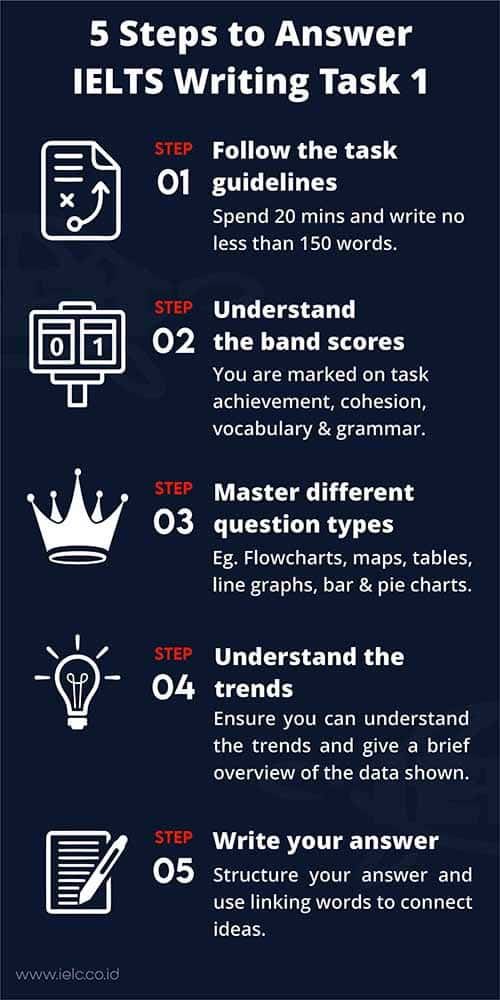
Tips & tricks for IELTS Writing Task 1
Are you confused about how to succeed in IELTS Writing Task 1?
With so much stuff on the internet, it’s hard to know where to start! At IELC, we’ve helped thousands of students achieve their target scores in IELTS with our IELTS course. And in this article, we’re going to share some of the secrets to success in IELTS Writing Task 1. If you want to nail IELTS Writing Task 1, you’re going to want to read this!

1. Understand the task requirements & follow the guidelines
It may seem obvious but you would be surprised how many people don’t understand the task requirements. Since they don’t understand the task requirements, they don’t follow the guidelines.
IELTS Writing Task 1 is only worth 33% of the overall Writing module score.
IELTS Writing Task 1 is important but you have to keep in mind that it is only worth 33% of the overall Writing module score. As such, you need to spend twice as much effort mastering IELTS Writing Task 2.
IELTS recommends that you only spend 20 minutes on Task 1.
Many people fall into the trap of spending 25 or even 30 minutes on Task 1. This is a big mistake! If you spending too much time on Writing Task 1, then it means you are not spending enough time on Writing Task 2, which is worth even more). Also, it means you are probably writing too much in Task 1.
You should write over 150 words.
Many people fall into the trap of writing either too little or too much. 150 words is a great guideline. So don’t write under 150 words!
However, there is no need to write 200 words either! 150 words the right number of words you need to write to get an optimal score. You can write more than 150 words (say 175 words) but there is no need to write 200 words! And it is definitely harmful for you to write 250 words. If you write 200-250 words, then you are NOT being efficient with your writing and you are probably repeating things. The key to good writing is being as efficient.
2. Understanding the Band Scores
You will be marked on the following:
- Task Achievement (25%)
- Coherence & Cohesion (25%)
- Vocabulary (25%)
- Grammar (25%)
Task Achievement
| Band Score 5 | Band Score 6 | Band Score 7 | Band Score 8 |
| – No clear overview – Key features not adequate covered – Too much detail – No data to support statements – Inaccurate information | – There is an overview – Highlights key features adequately – Information is well selected – Some information may be inaccurate | – A clear overview – Clearly highlights key features – No inaccurate information – Some areas could be better developed | – A clear overview – Key features are clearly highlighted and well illustrated – All requirements are sufficiently covered |
Coherence & Cohesion
| Band Score 5 | Band Score 6 | Band Score 7 | Band Score 8 |
| – Some organisation of information – Limited paragraphing – Problems with linking words – Repetitive lack of referencing | – Organised information coherently – Reasonable paragraphing – Uses linking devices effectively – Errors in linking between and within sentence – Referencing may be faulty | – Logically organises information – Paragraphing is sufficient – Uses a range of linking devices – May over or under use linking devices – No problem with referencing | – Information and ideas are organised logically – Paragraphing is sufficient – Manages all aspects of linking and cohesion – No problem with referencing |
Lexical Resource
| Band Score 5 | Band Score 6 | Band Score 7 | Band Score 8 |
| – Minimal range of vocabulary for the task – Frequent errors with spelling or word formation – Problems cause difficulty for the reader | – Adequate range of vocabulary for the task – Uses some less common words but with errors – Some errors in spelling and word formation – Communication is clear | – A sufficient range of vocabulary for some precision – Use less common words – Some awareness of style and collocations – Occasional errors in spelling or word choice | – A wide range of vocabulary for precise meaning – Skilfully uses less common words – Rare errors in spelling or word formation |
Grammatical Range & Accuracy
| Band Score 5 | Band Score 6 | Band Score 7 | Band Score 8 |
| – Limited range of sentence structures – Tries to use complex sentences with limited success – Frequent errors in grammar – Errors in punctuation – Problems cause difficulty for the reader | – Uses both simple and complex sentence structures – Some errors in grammar – Some errors in punctuation – Communication is clear | – Uses a variety of complex sentence structures – Most sentence are free of errors – Occasional errors in grammar or punctuation | – Uses a wide range of complex structures – Most sentence are free of errors |
3. Master different IELTS Writing Task 1 types
The first thing to know about IELTS Writing Task 1 is that there are a number of different question types. You will have to become familiar with and learn the following different question types:
- Bar Chart
- Pie Chart
- Line Graph
- Table
- Flowchart or Process
- Map
- A comparison of two or more of the above
In this article, we can’t give you a complete summary of every question type. We will write other Blog articles to deal with each of these questions types separately.
4. Understanding the trends
The key to Writing Task 1 is identifying the trends and presenting them to the examiner. Most people make the mistake of writing every single bit of information given in the question. This is a big mistake! The examiner wants to see if you can identify the trends and give a summary of the chart, graph, table, process, map. Once you have showed the examiner that you can give an overall summary of the trends, then you can back up this summary with specific, detailed information.
5. Writing your answer
Now it’s time to deal with writing your Task 1 answer. IELTS writing task 1 is not an essay, it’s a report. As such, you need to organise your information into a coherent order. The examiner will definitely check the structure of your answer.
There are three or four main paragraphs you need to use for task one. The first paragraph will be your introduction and will contain a description of the graph as well as the overall trend. Do NOT copy the question. You may paraphrase the question and mention the overall trend. We will deal with how to do this in a separate article.
The next paragraph is the overview. This is the most important article and deals with the key features of the graph, chart, map etc. For example, the highest point and lowest point.
The next paragraph deals with the detailed information. This is where you put the detailed information…such as numbers and percentages and comparisons.
The final paragraph, which is optional, gives a summary. Do NOT simply repeat information you have already discussed. Writing Task 1 is short so don’t repeat yourself. Here, you should deal again with the overall trends and what they indicate.
Do you want to achieve your IELTS target?
We just shared 5 secrets to succeeding in IELTS Writing Task 1. We hoped you enjoyed this article and hope this helps you with your IELTS preparation.
But if you want to guarantee success in your IELTS test…
AND
If you’re tired of wasting time and money on strategies and courses that don’t work…
AND
If you’re confused about which IELTS course to take…
The best IELTS preparation course in Indonesia
Check out our IELTS Preparation Course to see how we can help you achieve your dreams.
At IELC, we teach IELTS the right way.
AND
We have helped thousands of IELTS test takers achieve their target IELTS score.
THAT’S WHY
We have the best record in Indonesia for helping our students achieve their IELTS targets.
Our experienced teachers will give you the tips, tricks and strategies you need to succeed in IELTS and achieve your dreams.
And we guide you the whole way so you know achieve your target IELTS score.
So contact us to book your FREE consultation now.
P.S If you are curious about your IELTS score, contact us to ask about our simulation tests complete with feedback for writing and speaking tests!
Sincerely,
Anthony McCormick
IELC Managing Director
